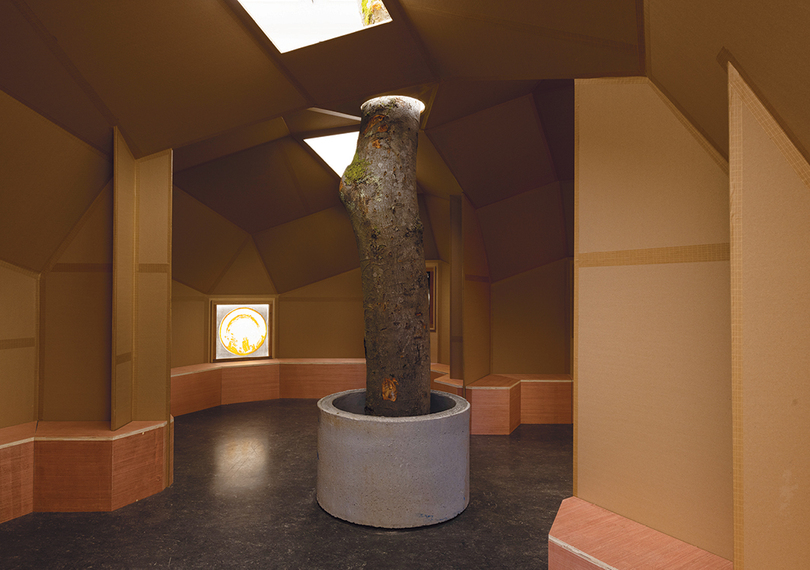
- Source: ARTFORUM
- Author: Live Drønen
- Date: JUN 1, 2023
- Format: PRINT AND DIGITAL
Oscar Tuazon
BERGEN KUNSTHALL

Oscar Tuazon, Los Angeles Water School, 2023, cardboard, wood, tape, tree, fountain. Installation view. From the series “Water School,” 2016–. Photo: Thor Brødreskift.
The high-ceilinged halls of Bergen Kunsthall’s 1930s functionalist building recently housed another, quite different take on functional architecture—one conjured by American artist Oscar Tuazon. Having dissected ideological, structural, and philosophical underpinnings of architecture, construction, and Minimalist sculpture throughout his career, Tuazon’s inauguration of his ongoing “Water School” in 2016 marked a turn toward more explicitly incorporating activist themes and strategies. The project consists of impromptu “schools” on the knowledge of water, physically taking place in structures modeled on Holly and Steve Baer’s dome-shaped Zome House, an experiment developed in the American Southwest in the early ’70s. Intrinsic to these houses is their capacity for being heated and cooled by sunlight and water—a technology also familiar to Indigenous architecture. Tuazon credits the 2016 Standing Rock protests and its key figures as his inspiration and teachers for “Water School,” stating that he first encountered the idea of such a phenomenon there, faced with slogans such as “Water is Life” and “Water connects us all.”
The exhibition in Bergen featured four models of wooden structures from previous iterations of “Water School”—all of which have taken place in conjunction with political battles for water and land rights in the US—at 60 percent of the original size. Built of cardboard, plywood, and tape, these appeared lightweight, situated at seemingly random intervals throughout the four rooms. Their windows are decorated with motifs of the sun and moon, trees and fire, and other subjects, which are powder-printed onto the glass. Inside one of these structures, Los Angeles Water School, 2023, a fountain built into a tree from Mount Fløyen in Bergen was peacefully circulating water and recalling the lake right outside the kunsthall’s building. As I walked in and around the models, their strange, irregular geometric structures seemed to change as I moved—sometimes appearing as shelters or playhouses, sometimes as sculptural articulations.
Accompanying the models was a selection of new and older sculptures and wall works, and five splendidly crafted masks by Tuazon’s friend and mentor, Native Alaskan artist Lawrence “Ulaaq” Ahvakana. The exhibition offered a density of information: The history and illustrations of the Baers’ Zome House, Indigenous architecture and knowledge, as well as specific political battles for waterways and land were thoroughly explained—in wall texts, a handout, and materials from the accompanying publication—as a theoretical framework for Tuazon’s project and its previous iterations. Especially valuable in this regard was the video Cedar Spring Water School, 2023, which features an interview with two prominent Newe people. As they speak of their physical and spiritual relationship to the water and land around Spring Valley, Nevada, and of the massacres of their ancestors that took place there between 1850 and 1900, a framework for historical awareness and thinking differently around ecological issues opens. As a relational project, “Water School” incorporates various means for activation, such as a library built into one of the models, as well as lectures and conversations. Despite interesting titles, the library seemed a bit gimmicky, or at best symbolic, both because of the abundance of information elsewhere and because it is insufficiently comfortable for longer studies. Exploring “the dynamics and power plays that regulate access to land, water, and infrastructures,” the programming included local practitioners and revolved around water, ocean studies, and Indigenous communities in Greenland. Although issues of Norway’s colonial history were mentioned within some events and mediation, I wished that there had been a discussion specifically devoted to this topic—especially as large-scale protests against ongoing government exploitation of land and violations of the human rights of Sámi people in Fosen were taking place in Oslo just as the show was on view.
The fragility of Tuazon’s cardboard models points to their impermanence; attending one of the conversations inside a “Water School” work, I didn’t dare lean back on the tenuous material. The objects embody the precariousness of both natural resources and cultural diversity within a colonial capitalist system. The exhibition’s strength lay in how Tuazon emphatically communicated this with an intelligent aesthetic awareness.

